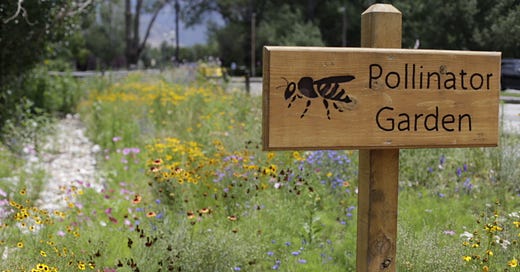We all know pollinators are in trouble and need our help. Habitat loss is a significant factor contributing to their declining populations.
Fragmented pockets of open landscape still exist but are isolated from each other due to ever-expanding urban sprawl. Restoring ecosystems and opening corridors so pollinators can move freely between areas of vegetation is a monumental task that must be addressed.
Adding native plants around your home is a great way to create pathways connecting habitats. If you don't have a lawn, no problem. You can support pollinators by putting a few planters on your deck or patio or sticking a few native flowers in a window box.
However, that may be easier said than done.
Not everyone has the time or money needed to plant a garden.
Some of us would love to dig in the dirt but have medical issues prohibiting outdoor activities.
While other people who are genuinely interested in helping bees, butterflies, and birds have absolutely no desire to get their hands dirty.
Is there something these folks can do to show their support for pollinators?
Donna Merrill, the founder of Pollinator Pathways, says yes, most definitely. An easy and most effective, clean-handed way is to do absolutely nothing. "Stop mowing your lawn. Stop using pesticides. Don't rake your leaves. If a tree falls and presents no danger, leave stacks of wood and brush for insects to use as habitat. Don't go to the lawn care section of a big box store and purchase plants treated with neonicotinoids or buy those big bags of God-only-knows-what in them."
In other words, relax and let nature take care of itself. A weed-free manicured lawn may please the landowner, but it is a wasteland, a desert, as far as other creatures are concerned. During the colder months, bees, butterflies, moths, beetles, birds, and small animals take advantage of the leaves and brush for their homes. In spring, clover and dandelions feed insects while they're waiting for other plants to bloom, and the prolific, yet unappreciated, indigenous weeds continue to draw in winged as well as four, six, and eight-legged visitors as the warm months progress through autumn and into winter. Before you know it, your previously barren and boring backyard becomes a pollinator wonderland!
It's amazing what you can do to support pollinators without even lifting a finger! And you make the bugs very happy, too.
It may take quite a bit of explaining to convince the homeowner's association why your usually manicured lawn no longer conforms to the norm, though. Have no fear; there are answers to the inevitable questions you'll face. For starters, I'm providing habitat for pollinators makes a fantastic conversation starter and piques the interest of your neighbors.
This leads us to another dirt-free vital role–educating others about pollinators' importance.
Spreading the Word
Donna began her pollinator conservation campaign by walking door to door through suburban neighborhoods, giving out free trees, and explaining why it was imperative to help the bees, butterflies, and birds.
Young and old alike bought into the ideas of incorporating more native plants into their landscape, removing invasive plants, and stopping the use of pesticides.
Word spread to neighboring communities, and Donna's simple act blossomed into a regional network of pathways for pollinators. From there, it expanded, eventually reaching other towns and states.
Following Donna's lead, education is the key that transforms an idea into reality—getting your neighbors to understand why you didn't rake the leaves or use Round-up™ on those dandelions open doors to teaching them about pollinators. Your contagious enthusiasm will spark their interest in attracting buzzing bumblebees and fluttering butterflies to their property. They'll tell their friends, and the cycle continues. It's another effective way to spread the word without dirtying your hands. Yet, it's as essential and necessary to pollinator conservation as planting native flowers, trees, and shrubs.
Reaching Out Through Community Activities
Next on your agenda could be organizing events, connecting with garden clubs, community colleges, schools, civic groups, and whoever else will listen. Donna makes that task easy by offering her tried and trusted toolkit, which has worked so well for her. There are also brochures, handouts, tips, suggestions, and articles on the Pollinator Pathways website, all free for the taking. Donna wants to ensure your success by sharing the knowledge, wisdom, and how-to's she has acquired over the years.
If you're serious about supporting pollinators, there are countless activities you can participate in. It's a team effort dependent on both those working in the field and the ones behind the scenes in organizing events and educating folks about pollinator conservation. Everyone is essential, and everything you do is greatly appreciated.
Now, it's your move!





